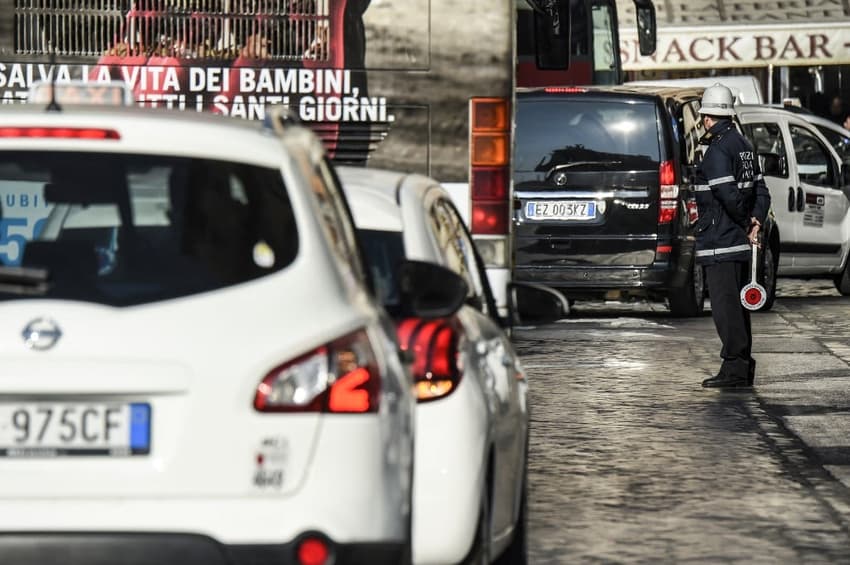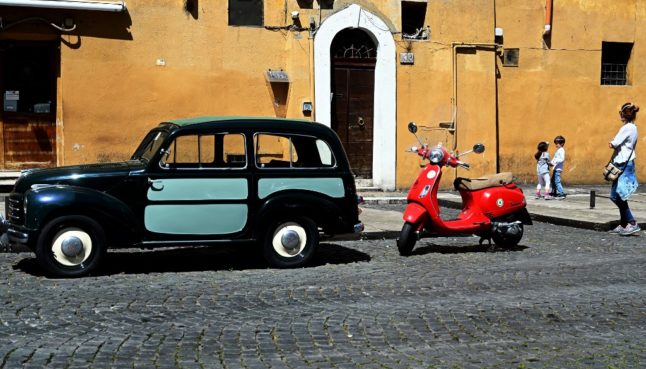OPINION: Italians and their cars are inseparable - will this ever change?

In a country as attached to the car as Italy, what would it take to get more people to use greener transport? Silvia Marchetti looks at what’s behind the country’s high levels of car ownership.
Many foreigners I speak to are shocked by the ‘car first’ mentality that rules in Italy, and by Italians’ degree of addiction to any wheeled vehicle.
There’s practically one car around for each Italian. Between 2010-2020 the population dropped but there were three million more cars on the roads, despite soaring living costs and falling salaries.
Italy’s rate of car ownership is the second-highest in Europe after tiny Luxembourg. All Italian regions have a lot of cars running but surprisingly, the number of passenger cars which is the highest at EU level can be found in the Alpine regions of Valle D’Aosta and the northern autonomous province of Trento, where particular regional statutes envisage special tax incentives helping locals to buy new cars.
Most Italians just don’t like walking. They aren’t active travelers who’d opt for a bike, and can’t go even 500 meters without a wheeled vehicle, be it a Jeep, motorbike, Vespa or motorino.
But it’s not really their fault. People in Italy haven’t been educated on eco-friendly modes of transport, simply because infrastructure like bike lanes, pedestrian paths, high-speed trains, efficient trams, subways and buses are rather lacking. And there aren’t many walkable pavements in cities, let alone in old villages. So the car is Italians’ second home.
READ ALSO: These are the most (and least) eco-friendly towns in Italy
There’s an historical reason for this, too. After the second world war, during the economic boom when Italy finally rose from the ashes of the defeat, owning a cinquecento or maggiolino was a status symbol. In the 1960s my father would squeeze eight friends into his cinquino and drive around all night, sharing the fuel cost. Then the car fad turned into a frenzy, and now it’s an obsession.

Iconic Italian car and motorbike models fuelled a post-war fad - which has become an obsession. (Photo by Vincenzo PINTO / AFP)
Whenever I need to go somewhere far from my house I wish I could do the entire trip by public transport and ditch my car, so as to avoid having parking problems too. I remember once when I was at university there was this huge party near the Colosseum, I drove around for an hour looking for a parking spot and eventually I gave up, went back home really frustrated.
Car sharing also is something totally foreign to Italians. You just need to look around in the morning at rush hour to see that there’s just one person per car, which is totally unsustainable climate-wise.
READ ALSO: Rome ‘among worst cities in Europe’ for road safety, traffic and pollution
Even in areas like Milan, where public transport is more efficient than in the southern regions, people still stick to their car or motorino which just proves how it’s a matter of mentality rather than of transport provision.
On the other hand, if I want to visit Tuscany or Umbria from my house in Rome’s northern countryside, there aren’t even any direct connections.
My Italian millennial friends refuse to take a bus or tram to the gelateria a few blocks away from their home - the car is the rule, and they don’t care if they risk a fine for double parking, or parking in front of a building entrance. Forget walking, it just isn’t ‘done’.
Italy will soon invest some €600 million in projects aimed at improving bike and pedestrian lanes under initiatives funded by the PNRR, but the mindset of drivers must also modernize for all this money to be really effective.
OPINION: Why cycling in Rome isn’t as crazy as it sounds
Italy needs an information campaign to raise awareness of environmental and health issues, and this must start inside schools and continue in college. Families also should educate kids to healthier transport modes, and stop buying those ‘micro cars’ when they’re 13 which don’t require a driver’s license.
I often ask myself what it would take to get Italians - but also other nationalities - out of their cars, or off their noisy motorino with illegal upgrades that make a hell of a noise. Rising oil prices haven’t done the miracle in making car ownership unaffordable.
Hiking car prices would kill the industry, so the only way is to give tax breaks or incentives to families who keep just one car and manage to share it, or raise taxes if each family member has one.
Perhaps in a very remote future, interconnected green transport from the doorstep to the destination might be the solution, but at the moment that’s science fiction.
Comments
See Also
Many foreigners I speak to are shocked by the ‘car first’ mentality that rules in Italy, and by Italians’ degree of addiction to any wheeled vehicle.
There’s practically one car around for each Italian. Between 2010-2020 the population dropped but there were three million more cars on the roads, despite soaring living costs and falling salaries.
Italy’s rate of car ownership is the second-highest in Europe after tiny Luxembourg. All Italian regions have a lot of cars running but surprisingly, the number of passenger cars which is the highest at EU level can be found in the Alpine regions of Valle D’Aosta and the northern autonomous province of Trento, where particular regional statutes envisage special tax incentives helping locals to buy new cars.
Most Italians just don’t like walking. They aren’t active travelers who’d opt for a bike, and can’t go even 500 meters without a wheeled vehicle, be it a Jeep, motorbike, Vespa or motorino.
But it’s not really their fault. People in Italy haven’t been educated on eco-friendly modes of transport, simply because infrastructure like bike lanes, pedestrian paths, high-speed trains, efficient trams, subways and buses are rather lacking. And there aren’t many walkable pavements in cities, let alone in old villages. So the car is Italians’ second home.
READ ALSO: These are the most (and least) eco-friendly towns in Italy
There’s an historical reason for this, too. After the second world war, during the economic boom when Italy finally rose from the ashes of the defeat, owning a cinquecento or maggiolino was a status symbol. In the 1960s my father would squeeze eight friends into his cinquino and drive around all night, sharing the fuel cost. Then the car fad turned into a frenzy, and now it’s an obsession.

Whenever I need to go somewhere far from my house I wish I could do the entire trip by public transport and ditch my car, so as to avoid having parking problems too. I remember once when I was at university there was this huge party near the Colosseum, I drove around for an hour looking for a parking spot and eventually I gave up, went back home really frustrated.
Car sharing also is something totally foreign to Italians. You just need to look around in the morning at rush hour to see that there’s just one person per car, which is totally unsustainable climate-wise.
READ ALSO: Rome ‘among worst cities in Europe’ for road safety, traffic and pollution
Even in areas like Milan, where public transport is more efficient than in the southern regions, people still stick to their car or motorino which just proves how it’s a matter of mentality rather than of transport provision.
On the other hand, if I want to visit Tuscany or Umbria from my house in Rome’s northern countryside, there aren’t even any direct connections.
My Italian millennial friends refuse to take a bus or tram to the gelateria a few blocks away from their home - the car is the rule, and they don’t care if they risk a fine for double parking, or parking in front of a building entrance. Forget walking, it just isn’t ‘done’.
Italy will soon invest some €600 million in projects aimed at improving bike and pedestrian lanes under initiatives funded by the PNRR, but the mindset of drivers must also modernize for all this money to be really effective.
OPINION: Why cycling in Rome isn’t as crazy as it sounds
Italy needs an information campaign to raise awareness of environmental and health issues, and this must start inside schools and continue in college. Families also should educate kids to healthier transport modes, and stop buying those ‘micro cars’ when they’re 13 which don’t require a driver’s license.
I often ask myself what it would take to get Italians - but also other nationalities - out of their cars, or off their noisy motorino with illegal upgrades that make a hell of a noise. Rising oil prices haven’t done the miracle in making car ownership unaffordable.
Hiking car prices would kill the industry, so the only way is to give tax breaks or incentives to families who keep just one car and manage to share it, or raise taxes if each family member has one.
Perhaps in a very remote future, interconnected green transport from the doorstep to the destination might be the solution, but at the moment that’s science fiction.
Join the conversation in our comments section below. Share your own views and experience and if you have a question or suggestion for our journalists then email us at [email protected].
Please keep comments civil, constructive and on topic – and make sure to read our terms of use before getting involved.
Please log in here to leave a comment.